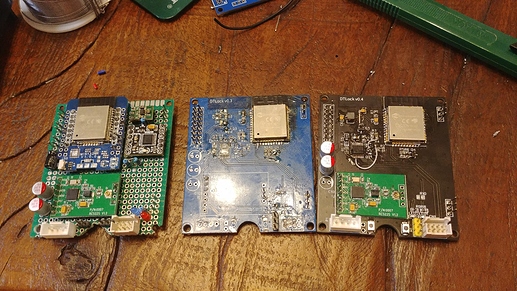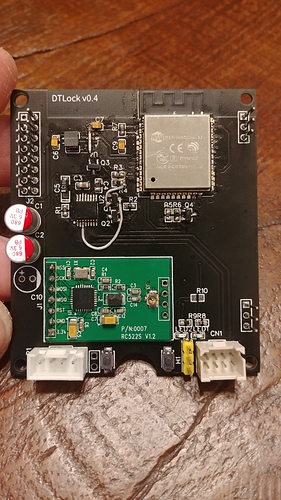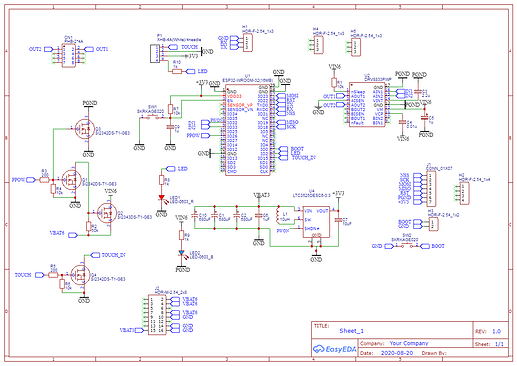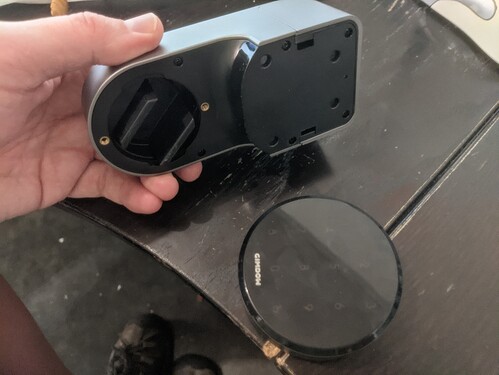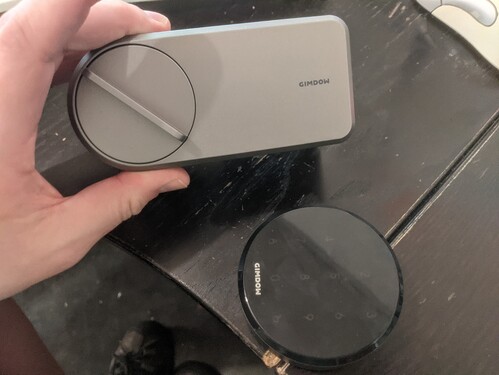…also called “the house”.
You’re not going to keep a determined thief out. That said, 99% of people will walk up, jiggle the handle, decide its locked and give up.
Windows and back door could be wide open, but it’s impenatrable cause it’s locked.
My mother keeps chickens. You could chainsaw giant holes in the coop walls and they’ll all still line up at the door in the morning waiting to be let out. Same thing.
About 50 days ago I received and soldered my second version “industrially-manufactured” PCB for my lock. It works much stable than my first samples, the batteries are still alive. Of course, I made some mistakes, same like forgot to connect couple ground polygones and incorrectly connected Boost DC-DC IC, which affected the power consumption (now about 100uA), but in fact this sample works for me already ~ 50 days, and it works well. I open this lock every day several times per day. ![]()
Tactical mod wires love it!
Maybe I’m talking from a paranoid point of view, but my personal experience is that flashy locks tend to attract more trouble. (houses with fancy electronic fences are robbed more often than houses with no security system, back at my hometown)
and as @thunderblaster already mentioned… I can “pick a lock” faster with my foot than with lockpics.
Although… damn, there are so many nice flashy designs you guys been posting!! <3
That said, my personal favourite is to integrate a wall-sided electronic lock instead.
This allows you to keep a normal looking lock (even if non-functional, or no handle/lock showing at all if you fancy some flash) on the door, and a wall panel which can be as flashy or obfuscated as you want. You can give in a printable face for companies to use, or a thin plaster-over layer for home users.
You don’t actually need to scan it from the inside, so a door handle would be enough.
Another advantage of wall-mounting it is that we can connect it straight to our mains to get rid of that pesky low-battery issue that @amal hates so much! (in my case, I’ll connect it to a battery first)
Also, no need for bluetooth/wifi. you can integrate it securely to a home system by cabling it internaly. if your smart home system is entirely offline (mine is), then there is no security concerns either.
Also making it modular could enable a single reader to trigger 2/3 deadbolts embedded on the same door, if you really need a door no one could kick down. (just remember, they might as well break in through the window. >.o)
There are new filaments that can be used on standard 3d printers that are infused with different metals that once printed can be finished and but able to stand up to heaver use.
ABS though printed with 100% infill will be rather strong and even able to place a steel rod in it while printing, can be a pain doing it but I have been able to do it before.
A benefit of an in-door deadbolt, though, is that it is unobtrusive to install and uninstall if someone’s not able to hack up their wall
Would this be the place to discuss a a rfid device that operates the existing lock or new thread?
Actually yes. Overall after doing more research, I’ve come to realize that the best approach for a lock project is to make one that can work with existing locks. This would solve several problems, most notably;
- house and apartment renters unable to change locks
- global versatility (for the most part)
In fact, I found a model that I would very much like to explore making a copy of… it’s a lock from a company called GIMDOW and the interesting thing about it is that it has an external keypad for mounting outside that is linked to the actuator inside over bluetooth. With the designs we’ve seen from things like the Ikea Rothult cupboard lock, it’s totally possible to battery power an RFID / NFC reader application… and since the reader part won’t be actuating, power from 2 or 4 AA batteries should be plenty to operate the external interface for a year or better.
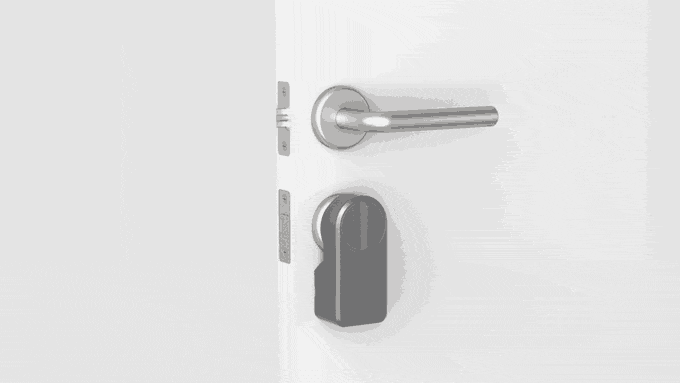
The best part is, both external “puck” and internal actuator can both be mounted using adhesive tape which are strong, but can be removed later without leaving a mark. Of course we would also make it possible to screw-mount the external puck if necessary for better security… but ultimately I think if we outright copied the mechanical design of this device and put our own PCBs inside we’d have a winner.
I would gladly send this lock to someone for disassembly and CAD replication to get this project moving again.
Maybe not true open source, but I might buy one, and try to shunt a XAC into it
The trick is figuring out how to make a single relay function for both open and close motion
My pistol safe uses a circle cam, that seems simple enough, but a dead bolt has quite a bit of throw
Also I’d like the knob to be able to turn when not powered (non cyborg wife wants to use key)
Maybe some form of a slip clutch
yep
that might be possible. there is no open/close button on the actuator like there is on the samsung ezon, but there might be a PCB level input you could use to kick it off.
I explored what’s available for zero-modification door addons such as this one. There are quite a few of those thumbturn motors out there, with quality ranging from very poor to quite nice. But they all have one thing in common: they work with a cellphone app that talks a cloud server. No internet, no lock.
I even bought one once (the Oviku Nero). The harware was okay for the price. But I tried to install the app on an older cellphone, and it didn’t work. I installed the previous version of the app and it worked, but then it connected to the company’s cloud server that immediately proceeded to update it to the version that didn’t work. I then reinstalled the old version without any internet connectivity on, and it told me that it wouldn’t work without the internet. Why of course, I need the internet to unlock my front door, obviously… How they intend to sell that thing to customers in Lapland where there isn’t even cellphone coverage in many places, I’ll never know.
Anyhoo, long story short: nice product ruined by a cloudiness. Needless to say, I promptly returned that one.
There is one thing to watch out for with thumbturn motors: many of they are designed to actuate deadbolts and don’t work with spring-loaded latches because the motor is too weak. A universal product like this would need a strong enough motor to actuate stiff thumbturns and stall long enough in the open position without burning out.
cloudy with a chance of deadbolts?
a decent existing set of hardware with a custom firmware and/or board would be smart
Any chance you talked to any of the manufacturers?
Any stats on force needed for these?
Yeah, I asked a few several questions (always the same), because I wanted to subvert the app with Tasker to turn the cellphone into an NFC unlocking thing:
- Does their app work without internet? Some do, most don’t.
- Does the app use forms or static images? Most reps didn’t know.
- Is the lock controllable with an SDK, or is the spec open for third party developers? Not on your life

I gave up on those things. The hardware can be nice, but it requires so much hacking / modification that it becomes pointless.
Yep: I measured one really stiff thumbturn at my company that I want to remote-control, and it clocks in at 6 kg.cm. So double that when you shop for a servo and it should cover all eventualities.
That explains why I can’t contact Santa ![]()
Either that or he is screening his calls…
Santa is staying at home all pilled up on Xanax. The coronavirus has gutted Rovaniemi’s stupid Santa-based tourism economy. Nobody’s going there this Christmas. It’s reverted to a nondescript drab little town in southern Lapland this year.
I have been looking and thinking on this project. I had the Idea of using a nodemcu or similar microcontroller. that will give you easy access to it via WIFI and could even ad a BT module to be able to control with BT. low power consumption and would be able to control any motors running with high power needs than what the controller could handle with the use of a optical switch. the CMU has plenty of room for program data, and no more than what is needed for this project would allow for future add ones. Added benefit is that it can all remain open source.
